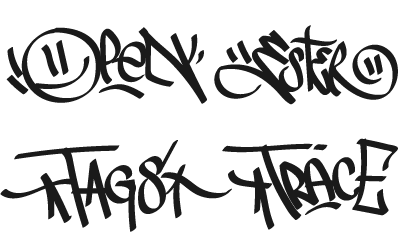Graffiti tagging is a fundamental aspect of urban street art culture, serving as a way for artists to leave their mark, claim territory, and gain recognition within the graffiti community. At its core, tagging involves writing one’s name or pseudonym in a highly stylized, often illegible manner using markers or spray paint. These tags become an artist’s personal signature, a way to express their identity and style in the public sphere.
Table of Contents
The Intro
The origins of graffiti tagging can be traced back to the late 1960s in Philadelphia and New York City, where young people began writing their names on walls and subway trains as a form of self-expression and rebellion against societal norms. As the movement gained momentum, tagging evolved into a complex subculture with its own rules, hierarchies, and styles, becoming an integral part of hip-hop culture alongside breakdancing, DJing, and rap music.
The Elements of a Graffiti Tag
A well-executed graffiti tag is designed to be visually striking and memorable, utilizing a combination of letterforms, colors, and textures to create a unique aesthetic. Some key elements of a graffiti tag include:
- Letterforms: Artists often manipulate and distort the shapes of letters to create a distinct style, making the tag difficult for outsiders to decipher. This can involve elongating, compressing, or interconnecting letters in creative ways.
- Flow: A skilled tagger will create a sense of movement and rhythm within their tag, using connecting lines and arrows to guide the viewer’s eye. The flow of a tag can convey a sense of energy, speed, or grace, depending on the artist’s intentions.
- Color: While some tags are monochromatic, others incorporate vibrant colors and gradients to add depth and visual interest. Color choices can reflect an artist’s personality, mood, or the surrounding environment.
- Texture: Techniques such as drips, splatters, and varying line weights can be used to create a sense of texture and dimensionality within the tag. These elements can make a tag appear more dynamic and tactile, as if it were jumping off the wall.

Example of different graffiti tags
The Significance of Graffiti Tagging in Urban Art Culture
Graffiti tagging has its roots in the 1960s and 70s, when young people in cities like New York and Philadelphia began writing their names on walls and subway trains as a form of self-expression and rebellion. As the movement grew, tagging evolved into a complex system of communication and competition among graffiti writers, each striving to develop their own unique style and gain notoriety within the community.
Today, while often controversial and illegal, graffiti tagging lettering has become a significant part of contemporary art and popular culture. Many successful street artists, such as Banksy and Shepard Fairey, began their careers as graffiti taggers before transitioning into other forms of art. The aesthetics of tagging have also been incorporated into graphic design, fashion, and advertising, demonstrating the lasting impact of this urban art form.
Graffiti tagging serves as a powerful form of self-expression for those who may feel marginalized or unheard in mainstream society. By leaving their mark on the urban landscape, taggers assert their presence and contribute to the ever-evolving visual culture of cities worldwide. Tagging can also foster a sense of community and belonging among graffiti writers, who often form crews and collaborate on larger pieces known as « throw-ups » or « productions. »
How to Create Your Own Graffiti Tag: A Step-by-Step Guide

Step 1: Practice the Graffiti Tag Alphabet
Before creating your unique graffiti tag, it’s essential to practice drawing the individual letters of the alphabet in a tagging style. Using the image provided as inspiration, follow these steps to practice your graffiti tag alphabet:
- Start by sketching a simple letter shape in pencil, focusing on creating a unique style that reflects your personality.
- Make two separate strokes with a marker to create a letter shape, experimenting with different angles and curves.
- Create an edgy look by using sharp angles and pointed corners, giving your letters a more aggressive appearance.
- Practice each letter repeatedly until you feel comfortable with its structure and style, then move on to the next letter in the alphabet.

Step-by-step process of creating a graffiti tag
Step 2: Adding Details and Refinement
Once you’ve practiced drawing the basic graffiti tag alphabet, it’s time to add more details and refinement to your letters. Consider the following techniques:
- Experiment with different line weights and thicknesses to create a sense of depth and dimension within your letterforms.
- Incorporate arrows, underlines, or other decorative elements to enhance the overall composition and flow of your tag. These elements should complement the letterforms and contribute to the tag’s visual impact.
- Play with the placement and interaction of letters, finding ways to connect or overlap them in a visually appealing manner.
- Refine your letter structures and details, ensuring that each element contributes to the overall aesthetic and style of your graffiti tag.

Step 3: Creating a Complete Graffiti Tag
With a solid foundation in the graffiti tag alphabet and an understanding of how to add details and refinement, you’re ready to create a complete graffiti tag. Follow these steps:
- Choose a name or alias that is short, memorable, and reflects your personality or interests. Avoid using existing tags out of respect for other artists.
- Sketch your tag on paper using a pencil or marker, focusing on creating a unique letterform style. Experiment with different shapes, angles, and connections between letters.
- Once you’re satisfied with your sketch, go over it with a marker or pen to create a cleaner, more defined version of your graffiti tag.
- Practice your tag repeatedly to develop muscle memory and consistency in your linework. Experiment with different writing tools, such as markers, brush pens, or chisel-tip markers, to find what works best for your style.
- Once you’re confident in your tag, find a legal outlet to practice it using spray paint, such as a designated graffiti wall or a large canvas. Remember to always prioritize safety and respect for property.
By following these steps and continuously practicing and refining your graffiti tag, you’ll develop a unique and stylized signature that represents your artistic identity within the graffiti community.
For more information on the history and impact of graffiti art, check out our in-depth article: The Best Guide to Graffiti Art: 10 Stunning Styles, Artists, and Impacts You Need to Know.
Conclusion
Graffiti tagging lettering is a powerful form of urban art that allows individuals to express their creativity, claim space, and contribute to the vibrant visual culture of cities worldwide. By understanding the elements and significance of tagging, as well as learning how to develop your own unique style, you can participate in this dynamic and ever-evolving art form.
Remember, the key to creating a successful graffiti tag is experimentation, dedication, and staying true to your artistic vision. Don’t be discouraged if your first attempts don’t live up to your expectations; like any skill, tagging requires practice and persistence to master. With time and effort, you’ll develop a signature style that reflects your identity and leaves a lasting impression on the urban landscape.
